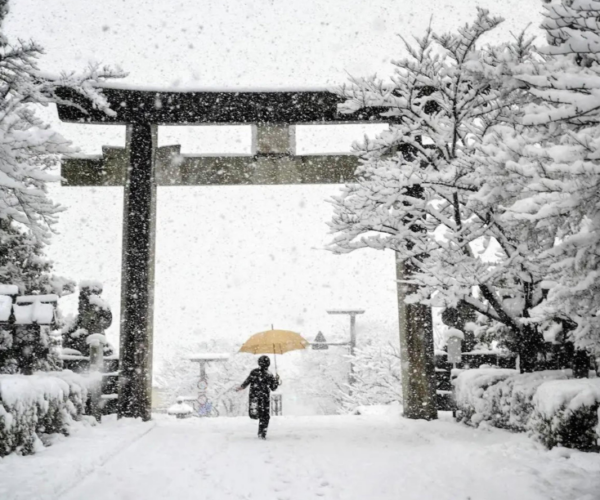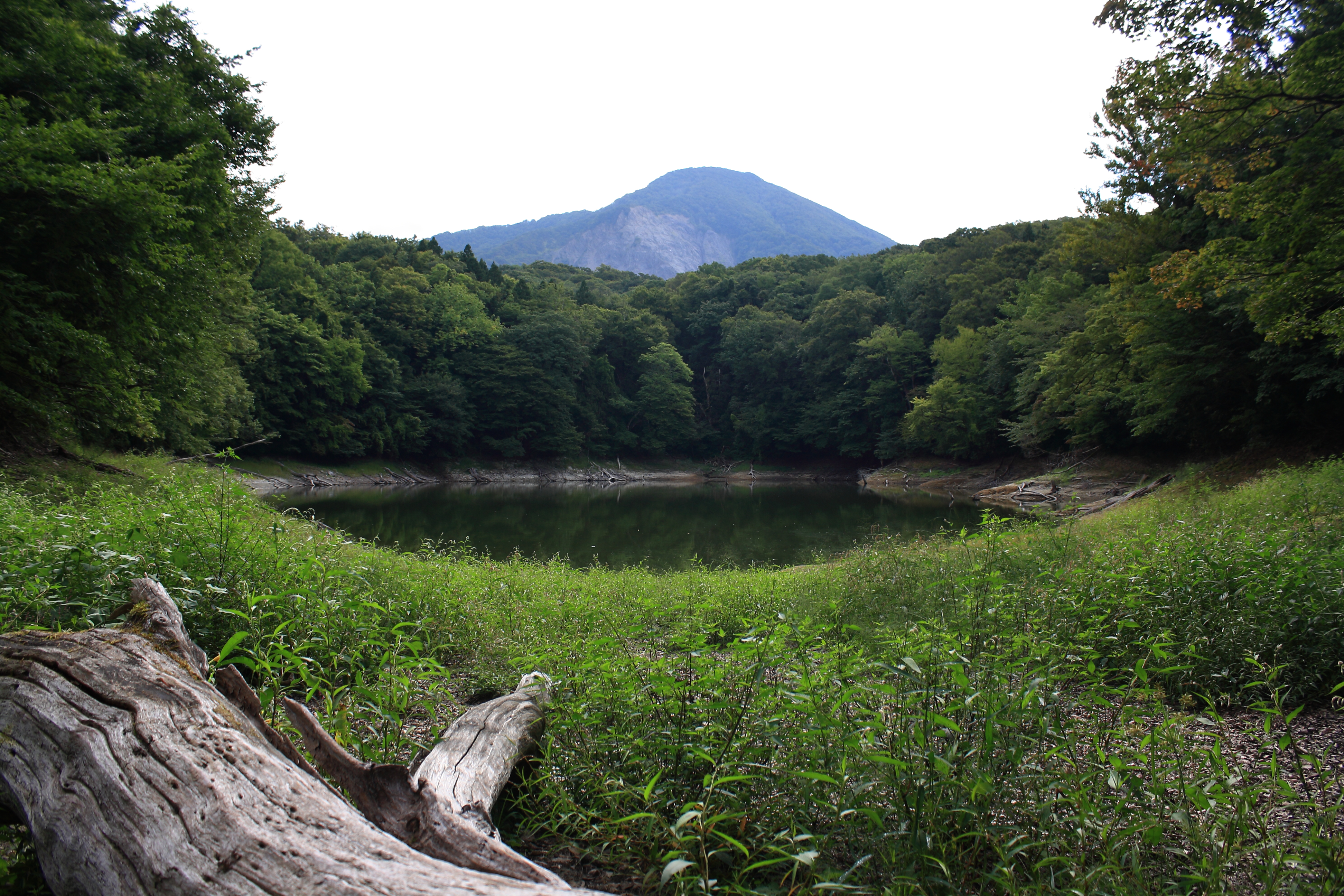This article originally featured in the December 2019 issue of Connect.
Reid Bartholomew (Aomori)

Photo by: Reid Bartholomew
Japan is home to four UNESCO Natural World Heritage Sites, three of which are difficult to reach from much of Honshū. As expected of places of untouched natural beauty, these sites are stuck in the more remote areas of Japan, making it hard to visit them without plenty of prior planning and more than a weekend off. Luckily for me, I was placed in Aomori Prefecture, which happens to contain perhaps the least well known of them: Shirakami Sanchi, a vast mountain range that stretches across the western half of Aomori and the northern edge of Akita.
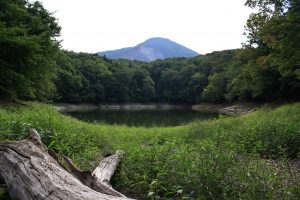
Photo by: Reid Bartholomew
I was first drawn to the area after having heard from a coworker of its reputation for steep hikes. As I looked into it, I found that tucked into the 1,300 square kilometers of densely packed forests were a plethora of natural wonders—some of the more famous ones being Aoike, a pool dyed electric blue from an excess of cobalt in the water, and Nihon Canyon, white cliffs that stand in sharp contrast to the surrounding expanse of green. It also boasts a number of waterfalls, lakes, and the last virgin beech forest in the country.
I was very excited to explore the Shirakami Sanchi—not only for the aforementioned attractions but even more so for the trails that lead to its peaks. After learning how close it was to me, I called up a friend of mine and we set out for the mountains on a three-day weekend. Unfortunately, we only had the chance to climb two peaks: Shirakami-dake and Fujisatokomaga-take, which sit at 1,232 and 1,158 meters high respectively. Had we had the time and planned a little more carefully, we could have chained together a few peaks into a full day’s loop. But as it was, two half-day hikes allowed us to see some of the more easily accessible sights in the mornings and finish our hikes before the sun set.
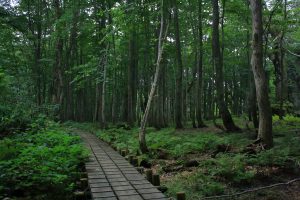
Photo by: Reid Bartholomew
Shirakami-Dake
Our first hike was up the namesake mountain on the western edge of Aomori: Shirakami-dake. The trail began rather gently, and the canopy of trees provided shade that kept the soil moist and dark, and the air somewhat cool, even in the end of the summer. There is definitely one thing that I can’t overstate about hiking in Shirakami Sanchi in the summer—everything is covered in green. Leaves fan out in every direction from the shrubs underfoot to the limbs overhead, and even much of the rocks are covered in a coat of moss—only the ash-gray bark of the beech trees served to break up the greenery. The landscape was so thick with lush forest that for most of the hike we couldn’t see beyond it. There wasn’t any way to tell exactly how far we had come until the top.
The gentle slope very quickly grew more severe with every meter, and eventually the hand ropes we had made fun of in the beginning became a godsend for pulling our exhausted bodies up the side of the mountain. Neither of us were strangers to hiking, and having blown through a few other hikes in Japan, we weren’t expecting to have such a difficult time of things. Our legs were burning as we approached the top, and our stomachs were starting to rumble a little thanks to an overconfident decision to leave most of our snacks in the car. Our breaks became more and more frequent, and less and less fulfilling. As much as we were struggling, we occasionally passed people easily three times our age, and I couldn’t help but feel a little humbled and inspired seeing them cheerily trucking along.
Our spirits were low when the dense foliage abruptly gave way to a shorter brush, and the landscape suddenly unfurled before us, a green blanket folding into ridges and valleys in every direction except the west, to which the hazy outline of the ocean was visible. Clouds and mist rolled over the earth, and the wind whipped at our sweat-stained clothes, bringing a bit of a chill. Two and a half hours later, we had reached the top.
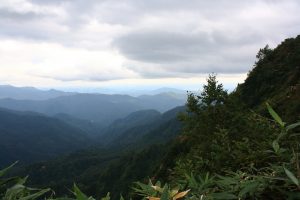
Photo by: Reid Bartholomew
Fujisatokomaga-taka
The next day brought us around to the middle of the core area in Akita, where we found ourselves looking up at Fujisatokomaga-take. Our legs felt more shaky and we were a little more humbled than the day before. Looking up into the trees, we debated if we even had the time to make it to the top and get back home at a reasonable fashion. Of course, our adventuring spirit won out over our concerns, and we laced up our hiking boots once again. When we started our climb, it started off rather easy with a march across wooden planks atop some mountain marshland. Luckily for us, this trail began higher up the mountain than the day before, but as if to balance this out, a light drizzle of rain fell on and off throughout the day.
The change in terrain was drastic after the marshes—steep doesn’t quite capture it. We found ourselves practically scrambling up the side of the mountain, using our hands to balance ourselves as we navigated the mud and rain-slick rocks. Even if there was sun to keep things dry, it wouldn’t get past the leaves overhead.
Although the hike was much shorter, the actual climbing was more intense than the prior day and required a lot more focus so as to not smash my camera or worse, my face, on the rocks below. The whole hike was accompanied with the heavy scent of wet earth and plants, mixing with the smell of our sweat-dampened clothes. This trail as a whole was earthier and rockier than Shirakami-dake—which led us to larger steps up what felt like a staircase of boulders.
This time, we reached the top in a mere hour and a half so the hike seemed to go by in no time. By the time we reached the top, the clouds had fortunately disappeared, letting us see out in every direction. Exhausted and wet, I let out a holler upon seeing the incredible view. The landscape pitched and wrinkled in smaller hills and valleys, like folds in a green blanket spread out right up to the edge of the blue sea. As tired as we were, we only stayed long enough to devour our snacks before bombing back down the trail.
The return trip was a little more anxiety-inducing. Mainly because the same slipperiness that had been a pain going up was a threat going down with a different center of gravity—a few times I lost my footing and thought I might tumble the rest of the way down. By the time we made it to the bottom, we had just enough daylight to settle into one of the several onsen in the area as a reward for all of our efforts.
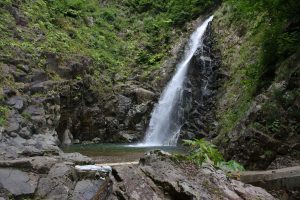
Photo by: Reid Bartholomew
Planning Your Own Trip
Despite spending hours winding through trails and mountain roads, there was still so much that we didn’t have the chance to see due to the sheer size of the area. As I looked over some guides and maps on the drive back home, I kept finding other trails and sights that we missed out on. The mountain range encourages multiple trips, offering something for every season. I recommend the area even for those who aren’t exactly keen on hiking, as many of the major attractions can be experienced by driving from location to location and taking short walks at each destination. In fact, some of the most beautiful moments of the trip came from looking out the window on drives through the mountains.
For the most part, accessibility shouldn’t be an issue. In the spring, summer, and fall, there is only one significant stretch of road that’s unpaved, and though our yellow plate car rattled through the gravel, there were no problems. However, being in Tōhoku, the landscape is an entirely different beast in the winter. While there are some opportunities to snowshoe and see some incredible snowy landscape, if you plan to go from November to May, you’ll want to factor road and trail closings into the equation.
Shirakami Sanchi is the perfect way to step away from the hectic aspects of life and spend some time in awe of the beauty of nature. With options to make the trip as intense or relaxing as you’d like and plenty of onsen to rest your legs at the end of the day, it’s a must-hike for anyone looking to come to Aomori.
Reid Bartholomew is an ALT and writer from the state of Arkansas in the United States, where the Ozark Mountains instilled in him a love for all things outdoors. He is drawn to people and their stories, which leads him to write about literature and his travels. Currently living in Oirase-chō in Aomori Prefecture, Reid spends his time outside of school jogging alongside rice fields and finding new places to hike.
All photos by: Reid Bartholomew
